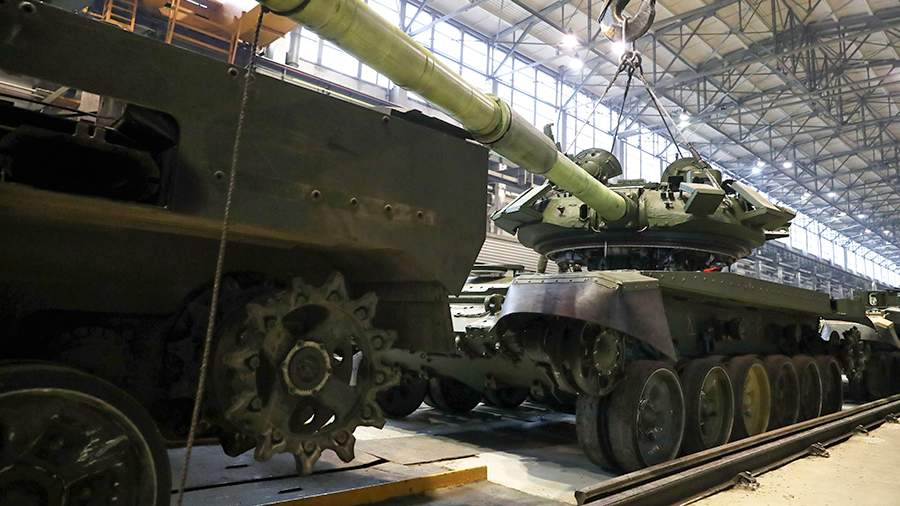In the wake of substantial tank losses in the Ukraine conflict, Russia’s state-owned Rostec corporation has ramped up its tank production sevenfold within a year.
Sergei Chemezov, the head of the state corporation Rostec, announced a remarkable surge in production figures, revealing that tank production has grown sevenfold in a year. At the same time, light armored vehicle manufacturing has seen a 4.5-fold increase.
In addition, some types of ammunition have seen an astounding 60-fold boost, as disclosed during his interview on Russia-24.
He stated, “We have increased production several-fold. In one year alone, the output of tanks was up seven times, of light armor — BMP, BMD, and other armored vehicles — 4.5 times, of artillery and MLRS — 2.5 times, and of ammunition and some types of products, 60 times.”
Chemezov also underscored the ongoing modernization efforts at Rostec, highlighting that the corporation’s equipment is continually evolving and improving.

In mid-October, Rostec delivered a batch of Agriculture Remote Mining Engineering System (ISDM) complexes to Russian military forces ahead of schedule. This system, featuring programmable munitions, can rapidly cover an area equivalent to several football fields within minutes.
On October 11, the Uralvagonzavod Research and Production Corporation, a subsidiary of the Uralvagonzavod conglomerate under the Rostec State Corporation, supplied the Russian Ministry of Defense with a shipment of T-90M Proryv and T-72B3M tanks equipped with enhanced protection.
At the time, Deputy Prime Minister of the Russian Federation and Head of the Ministry of Industry and Trade, Denis Manturov, said that these models are in high demand, having demonstrated exceptional performance in the Ukraine war.
In a previous statement, Alexander Potapov, who serves as the CEO of the Uralvagonzavod Concern (UVZ), a division of Rostec, also revealed that they are currently exploring the feasibility of manufacturing T-80BVM tanks entirely from the ground up.
According to Potapov, this particular endeavor is a top priority for the company, as the military authorities have explicitly requested it. The firm is deeply involved in collaborative efforts and addressing the complexities associated with this project.
Massive Tank Losses Plague Russian Forces
The significant increase in Moscow’s tank production by a factor of seven within a year is likely a direct response to the substantial losses experienced in the ongoing conflict.
Moscow has been strengthening its armed forces and increasing weapons production, anticipating an extended conflict in Ukraine, where the front lines have remained relatively static for nearly a year.
In the initial phase of the war, inadequate planning on the part of the Russian forces led to significant tank losses, particularly during the ill-fated assault on Kyiv.
During that operation, a large number of tanks and armored vehicles were destroyed while advancing in a convoy on roads north of the capital.
Furthermore, Russian tanks have fallen short of delivering a decisive advantage in Ukraine, and as a result, Russian forces have incurred huge tank losses in the battle.
On the other hand, Kyiv has acquired modern battle tanks from Western allies and has actively deployed them in its ongoing counteroffensive.

According to Oryx, an open-source intelligence group that tracks wartime equipment losses, Russia has reportedly lost nearly 2,500 tanks in its military campaign in Ukraine. However, Oryx’s tally encompasses only the tanks that their members can visually confirm through social media sources.
In essence, it represents a conservative estimate. Many observers believe that the actual losses, encompassing destroyed, damaged, and captured tanks, could exceed this figure.
In response to these losses, Russian defense factories began to intensify the production of tanks and armored vehicles.
In addition to the tank losses, according to US officials, Russia’s military casualties have reached an estimated 300,000, including approximately 120,000 fatalities and 170,000 to 180,000 injured troops.
At the end of September, the Russian President made an announcement regarding the enlistment of 130,000 young men for compulsory service in the military during the fall.
When combined with the 147,000 men drafted in the spring, Russia’s Defense Ministry aimed to field a total of 277,000 conscripts in 2023. This recruitment window extended from October 1 to December 31, allowing Russia’s military to call up men aged 18-27 for their 12-month training period.
In October, Russian Defense Minister Sergei Shoigu said that more than 335,000 individuals had signed up to serve in the armed forces or voluntary units this year.
Despite this, he underlined that the armed forces already possessed the necessary military personnel to carry out the ongoing special military operation. Therefore, there were no plans for additional mobilization.
- Contact the author at ashishmichel(at)gmail.com
- Follow EurAsian Times on Google News




